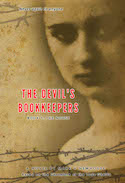
 |
History textbooks often provide facts in lieu of telling stories. In Newhouse’s historical fiction, largely based on the Chronicle of the Lodz Ghetto, 1941-1944, these stories are brought to life, a conjuring of what those resilient souls must have endured daily. Through the lens of the main character, Benny Ostrowski, readers gain the opportunity to experience what it must have been like to live, love, and grow in such a terrifying time. As each chapter progresses, the narrative becomes simultaneously more mesmerizing and haunting. Sealed off from the world in the Lodz Ghetto, the Jewish community was stripped of its dignity—and most material possessions—with the ever-looming Nazi noose becoming increasingly tighter.
Newhouse’s mastery of prose yields rare results: it is a piece that does justice to the historical aspect of the lives of those quarantined in the ghetto, while depicting characters who, despite their dire circumstances, are able to find moments to live for. Even within the unfolding tragedy, the central characters find time for humor, often at their own expense. The narrative commences with Ostrowski mulling the many reasons why M.C. Rumkowski, best known as the Chairman, the Eldest of the Jews, and the Devil, would ask to meet him. The palpable fear and anxiety in Ostrowski during these types of situations bring the character to life as authentically as possible.
The pairing of Ostrowski with the two Oscars—Dr. Oskar Rosenfeld and Dr. Oscar Singer—in addition to the more emotionally sound (at least initially) Julian Cukier, is the core of Newhouse’s work. Unsurprisingly, it does not disappoint. Moments of comic relief are interspersed within the daily heartwrenching headlines that the group is discreetly asked to chronicle. Whether it is with his wife, Miriam, or his coworkers, especially Oscar Singer, Ostrowski is the anchor that keeps those around him from going insane while daily headlines seem to get more and more mind-boggling.
Newhouse’s prose is abundant with vivid imagery that is seared into the reader’s mind. One image that will perhaps remain with most readers is one in the earlier part of the book. Ostrowski is elated to give the good news of his job to Miriam and is running back home. When he is stopped by the Jewish police, the simple act of his papers falling to the ground initiates a myriad of thoughts in his and. of course, the reader’s mind of whether one slight move and his body will be riddled with bullets. In another chronicling of days in the ghetto, it is excruciating to see how something as minuscule as coal is kept away from the population, essentially leaving them to freeze. From the revelation of mass graves to market stalls being demolished so the Germans and high-ranking Jewish community could have wood for lumber and fuel, many factors indicate that the entire community has gone so far down the rabbit hole of terror that any hope of genuinely having their lives return to normalcy once the war concluded is simply fool’s gold or outright delusion.
In Newhouse’s own words, the Lodz Ghetto was headed toward two likely outcomes: “annihilation” and insanity. While there is no comparison that could justify Nazi actions, the opening of each chapter is like getting poked in the same location over and over, never really giving the original wound a chance to heal. Heartbreakingly, any fight the Jewish community was able to demonstrate without instant death could be narrowed down to an insane woman who intentionally reached the barbed wire and instructed the sentries to shoot her. Ostrowski dreams of this woman with Miriam’s face; his constant worry, he fears, will be realized: he will lose Miriam and their family.
The reality is that many Jewish families realized the fate that Ostrowski fears; the numbers went from over 200,000 to a middling 5,000 by the end. Newhouse’s own parents represent two of those who were left, a fact that is singularly the most influential reason for this book’s existence. Ultimately, what makes this book so appealing is the duality of reading a text that is influenced in truth and history and delivered in a historical narrative that will have audiences conjecturing the fate of their main characters. Many texts exist on the topic of Jewish treatment by Nazis, but few execute the story with such clarity and enjoyment. Readers will get an experience that goes far beyond education or entertainment. It transcends history. NOTE: Book 3 in the series has won the 2021 Eric Hoffer Book Award for Historical Fiction.
RECOMMENDED by the US Review